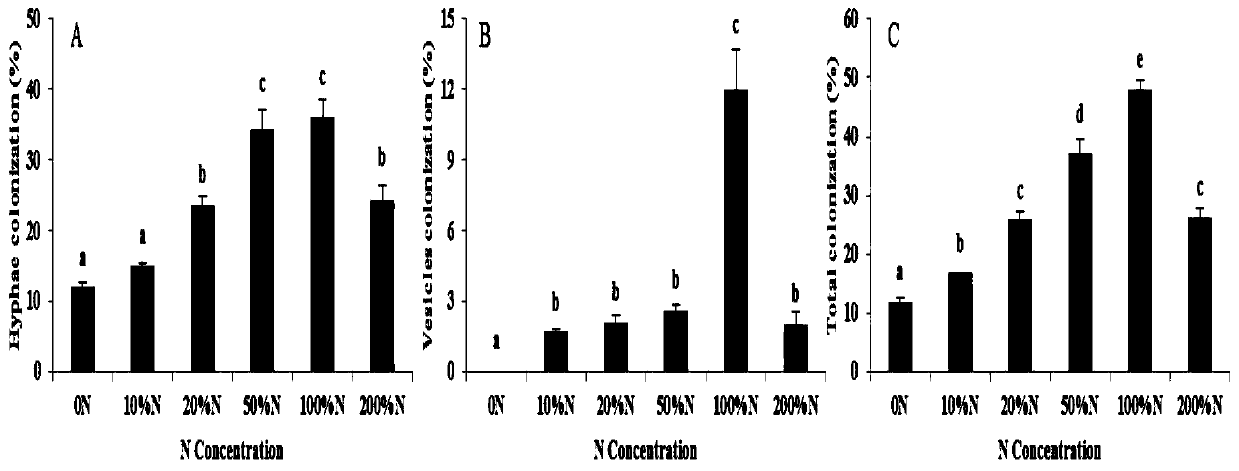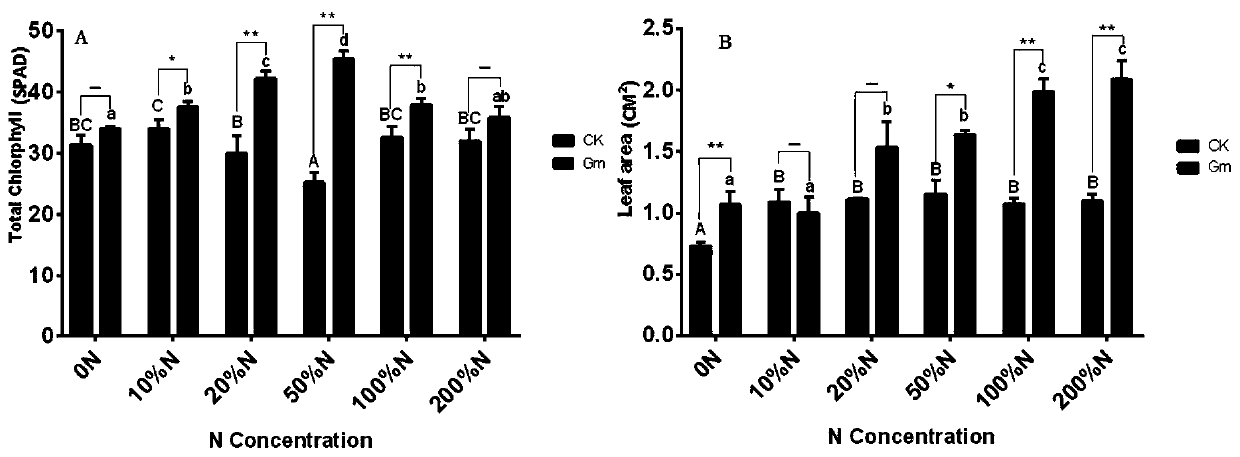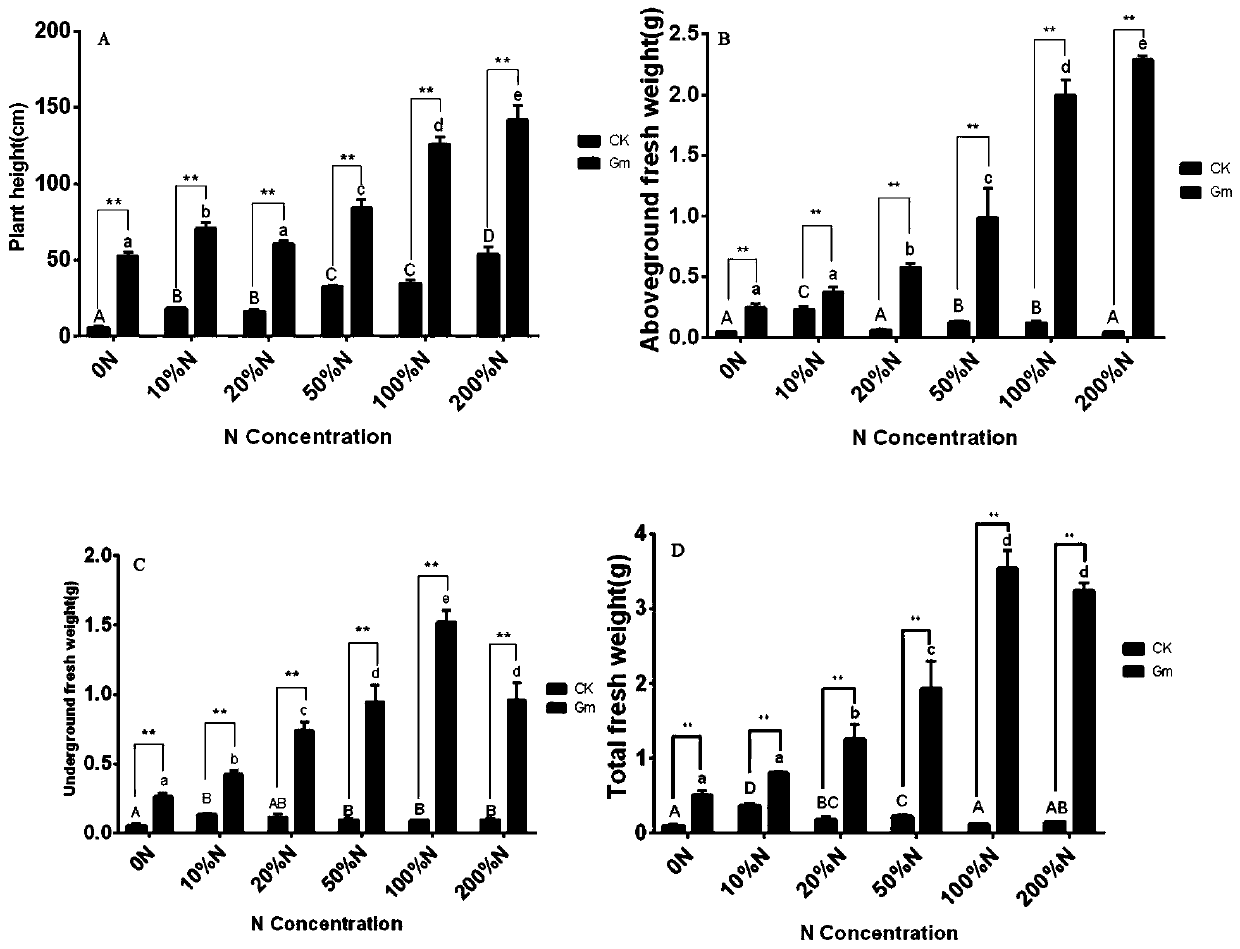Method for improving total flavonoid content and yield of clematis plants by using arbuscular mycorrhizal fungi
A technology of arbuscular mycorrhizal fungus and clematis genus, applied in the direction of microorganism-based methods, botany equipment and methods, biochemical equipment and methods, etc., which can solve the problems of unsuitable cultivation measures, quality decline, and unstable medicinal properties And other issues
- Summary
- Abstract
- Description
- Claims
- Application Information
AI Technical Summary
Problems solved by technology
Method used
Image
Examples
Embodiment 1
[0034] Embodiment 1. Preparation of test materials
[0035] The seeds of Clematis chrysanthemum for testing were collected from Manhan Mountain in Liangcheng, Inner Mongolia. The tested strain was Glomus Mosseae-Gm, which was purchased from the Germplasm Bank of Arbuscular Mycorrhizal Fungi (BGC).
[0036] Nutrient solution for test: Hoagland nutrient solution of total nitrogen and phosphorus including 3mM KNO 3 , 2mM NH 4 NO 3 , 0.5mM KH 2 PO 4 , 1mM MgSO 4 , 0.5mM KCl, 0.5mM FeC 6 h 5 o 7 , 0.0125mM H 3 BO 3 , 0.001mM MnCl, 0.001mM ZnSO 4 , 0.00025mM CuSO 4 and 0.00025mM Na 2 MoO 4 , pH 6.5.
[0037] The test set up 6 levels of N application (KNO 3 and NH 4 NO 3 ) and 6 levels of P application (KH 2 PO 4), represented by 0N, 10%N, 20%N, 50%N, 100%N, 200%N and OP, 5%P, 10%P, 20%P, 50%P, 100%P respectively, the same Two treatments of inoculation (Gm) and non-inoculation (CK) were set for N and P levels, each treatment was repeated 3 times, and the test pot...
Embodiment 2
[0039] Embodiment 2. Test items and methods
[0040] 1. Effects of inoculating AM fungi at different levels of nitrogen and phosphorus on physiological growth indicators or active ingredient content of Clematis chrysalis
[0041] (1) Determination of chlorophyll content: Chlorophyll analyzer SPAD-502.
[0042] (2) Leaf area measurement: LI-3000 portable leaf area meter.
[0043] (3) Determination of plant height: measurement method.
[0044] (4) Determination of biomass (fresh weight above ground, fresh weight below ground, fresh weight of whole plant): weighing method.
[0045] (5) Determination of soluble protein content: Coomassie brilliant blue G-250 method.
[0046] (6) Determination of proline (Pro) content: acidic ninhydrin method.
[0047] (7) Determination of malondialdehyde (MDA) content: TBA method.
[0048] (8) Determination of peroxidase (POD) activity: guaiacol colorimetric method.
[0049] (9) Determination of total flavonoids in Clematis chrysanthemum: UV...
Embodiment 3
[0054] Example 3. Research on the mechanism of inoculating AM fungi at different nitrogen levels to regulate the growth and active ingredient content of Clematis chrysalis
[0055] 1. Mycorrhizal infection rate of Clematis chrysanthemum under different nitrogen levels
[0056] The present invention observes the mycorrhizal infection of the root system of Clematis chrysalis after 6 months of inoculation of Gm treatment under different nitrogen levels: the mycelia and vesicles of the inoculated strain root cells can be clearly seen The mycorrhizal infection rate of uninoculated strains was 0. From figure 1 It can be seen that Gm can infect the root system of Clematis chrysanthemum and form mycorrhiza under different nitrogen levels, except for 0N level (root vesicle infection rate is 0)( figure 1 B). The mycorrhizal infection rate was different under different nitrogen levels, but within a certain nitrogen level range, the root mycelial infection rate, vesicle infection rate ...
PUM
 Login to View More
Login to View More Abstract
Description
Claims
Application Information
 Login to View More
Login to View More - R&D
- Intellectual Property
- Life Sciences
- Materials
- Tech Scout
- Unparalleled Data Quality
- Higher Quality Content
- 60% Fewer Hallucinations
Browse by: Latest US Patents, China's latest patents, Technical Efficacy Thesaurus, Application Domain, Technology Topic, Popular Technical Reports.
© 2025 PatSnap. All rights reserved.Legal|Privacy policy|Modern Slavery Act Transparency Statement|Sitemap|About US| Contact US: help@patsnap.com



